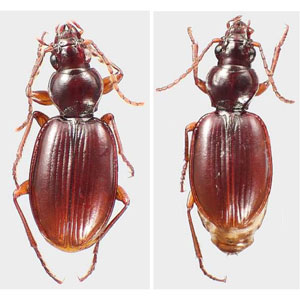
Left: male M. neonomas. Right: female M. neonomas. Photo: Kip Will.
Two new species of carabids (ground beetles) were identified at a National Ecological Observatory Network (NEON) field site at Pu’u Mala’ala Natural Area Reserve (PUUM) in Hawaii.
Dr. Kip Will, of the University of California, Berkeley, and Dr. James Liebherr, of Cornell University, recently published their findings in The Pan-Pacific Entomologist: “Two new species of Mecyclothorax Sharp, 1903 (Coleoptera: Carabidae: Moriomorphini) from the Island of Hawai’i.”
The two new species are both members of Mecyclothorax, a genus of ground beetle most diverse on volcanoes in the Hawaiian Islands and the Society of Islands of French Polynesia.
The newly named Mecyclothorax neonomas and Mecyclothorax brunneonubiger bring the number of known Mecyclothorax species in Hawaii to 241, many of which were previously described and cataloged by Dr. Liebherr. Their discovery could provide new insights into the evolutionary history of the genus.
Dr. Will is one of the two researchers contracted by the NEON program for definitive identification of carabids. He studies carabids worldwide and provides identification for the NEON program for carabids in the western United States, including Hawaii.
Dr. Liebherr is one of the premier U.S. experts on carabids, especially those of the Hawaiian Islands. Over the last 20 years, he and his students have created what is considered by many to be the most extensive and authoritative guide to Hawaiian carabids to-date.
Dr. Will first discovered the suspect specimens in a group of carabids sent to him for identification from PUUM.
“When the NEON samples arrived for identification, it was my first time seriously working with Hawaiian carabids,” he said in a news release.

Male M. brunneonubiger. PHOTO: DR. KIP WILL
Dr. Will also noted in a news release that he quickly realized that two of the specimens did not match species already described in Dr. Liebherr’s publications. He sent the specimens to Cornell, where Dr. Liebherr confirmed the identification of two new species. Discovering new carabid species is par for the course for these researchers, but these are the first new Hawaiian carabid species identified with NEON samples.
Carabids are found in practically every ecosystem across the globe, with an estimated 35,000 to 45,000 species worldwide and nearly 2,500 known species in the U.S. alone. They are also good environmental indicators. Many species are highly specialized for their habitats and very sensitive to changes in the environment. These characteristics make them ideal subjects for NEON data collection.
The NEON program collects ground beetles in pitfall traps at terrestrial field sites. Studying carabid populations across geographic regions and over time can provide insights into climate and ecosystem change and ecosystem dynamics.
In the years to come, the NEON program’s carabid data will allow researchers to keep a close eye on shifting populations in Hawaii and across the country. One issue Dr. Will plans to keep an eye on in Hawaii is the impact of invasive carabid species on native Hawaiian species.
Leave A Comment